- Camping Tips
- Hiking Tips
- RV Camping
- Destinations
- Blog
- Gear Reviews
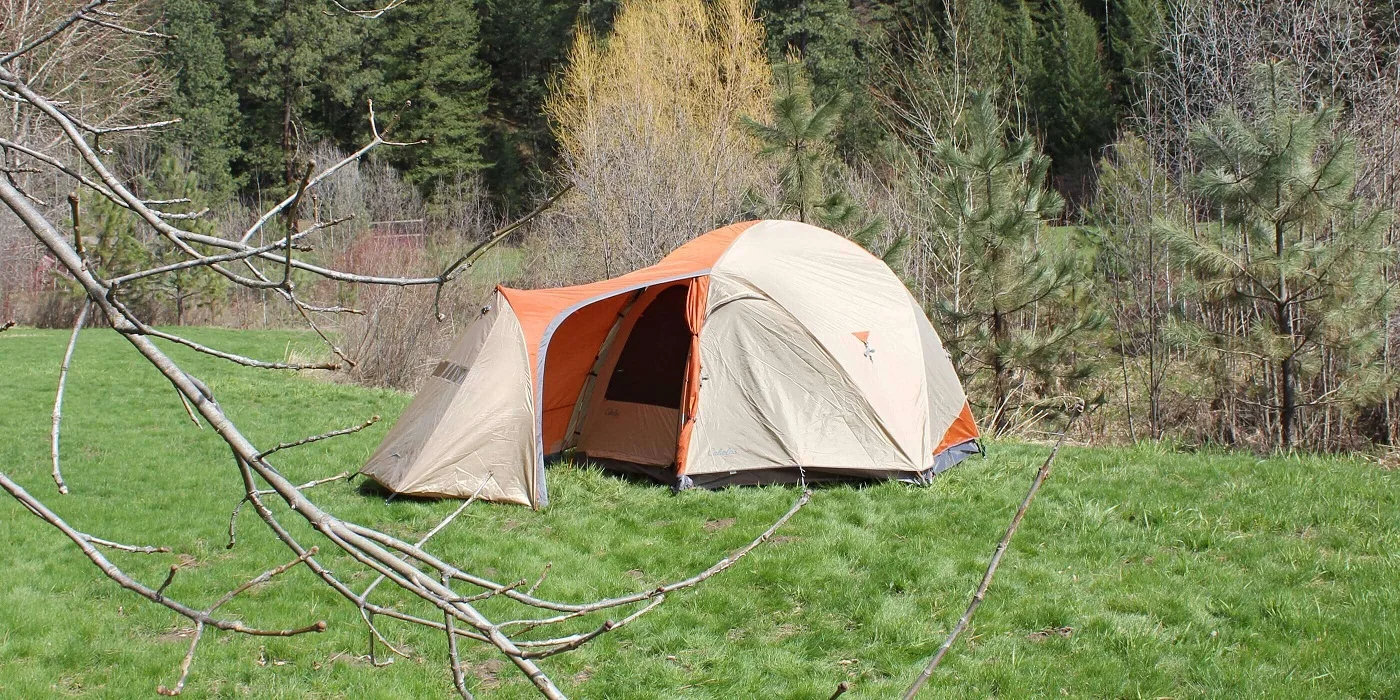
Our recommendations are based on thorough independent research, testing, analyses, and comparisons of different products. When you make purchases through links on our website, we may earn affiliate commissions.
With floor areas ranging from 54 square feet to about 70 square feet, four-person tents are the most preferred by budding families and small groups of campers. However, with so many differences in sizes, seasonality, and brand availability, choosing the most appropriate tent for your upcountry camping can prove herculean even for the most seasoned camper.
In this guide, we intend to bring forth some of the most top-notch tents in the four-person category. We do so by answering some of the most critical questions that should act as a guiding principle for tent selection.
For instance, how big is the camping group you intend to bring along? What other camping equipment do you need to carry? Will you need to set up a cot or two in the tent, or will you need a table and chairs from which you can sit and enjoy games when the temperature is too harsh to venture into outdoor activities? What season do you intend to camp in?
It is our sincere hope that you will find in this list a tent that suits all your outdoor needs. At the minimum, we at least hope that you will not purchase something that will be a source of disappointment.
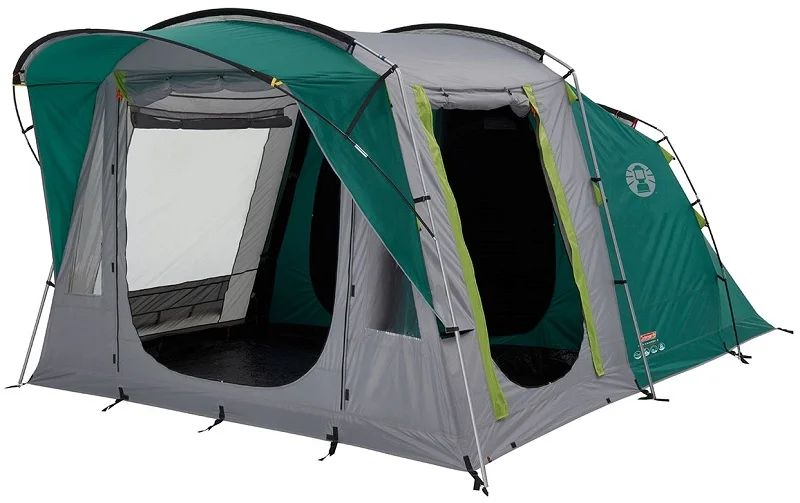
With its over 120 years of experience making outdoor essentials, the Coleman brand is a solid option to consider when shopping for camping tents. Speaking of which, their Oak Canyon 4 and FastPitch Instant Cabin 4 tents come to mind.
Like most of their products, Coleman tents are known for their high quality, practical features, and sometimes, affordable prices.
The Coleman Oak Canyon 4 has a length of 15 feet and a width of 9 feet. As a result, you'll have a large living area and two partitioned bedrooms, ideal for a family of four. The tent's tunnel form and high ceiling add to the comfort and livability within.
On the other hand, the FastPitch Instant Cabin 4 is slightly dwarfed in terms of space given that it only measures about 8 feet in length and 7 feet in width. At just under 5 feet, its peak height is shorter than that of the Oak Canyon 4 tent. As a result, taller people may be unable to stand properly and stroll around within.
Comfort and privacy are at the center stage of the build and design of the Oak Canyon 4 tent. The tent has blackout interiors guaranteed to block out most of the sunlight for a cooler and longer sleeping experience. Its large PVC windows provide epic views of your surroundings and the attachable covers help provide some privacy.
While the FastPitch Instant Cabin 4 has a more straightforward approach, the Oak Canyon 4 feels roomy and cozy. That said, both options still tower above most four-person tents available in the market.
Most Coleman tents are built to last, and these tents are not an exception.
Both tents feature steel and fiberglass poles, a good combo for a strong and wind-responsive support structure. Additionally, their floors are made of tough polyethylene fabric that will be sure to withstand most ground conditions.
In the Oak Canyon 4, water protection is greatly enhanced by the PU-coated polyester fabric, taped seams, and welded floor corners. Wind responsiveness is kicked up a notch with its perforated mesh pole sleeves that allow for air to pass through.
Similarly, the Coleman FastPitch Instant Cabin 4 remains adequately weatherproof owing to its waterproof fabric and partial rainfly.
Both tents have vents and large bug-screened openings, so you won’t have any condensation build-up issues in either. However, the Instant Cabin 4 performs better as a two-season or warm weather shelter while the FastPitch tent is a solid 3-season tent with a remarkable hydrostatic rating of 4500 millimeters.
Featuring an instant design, the Coleman FastPitch Instant Cabin 4 is a sure winner when it comes to set-ups and packing away. The poles come pre-attached resulting in a straightforward three-step assembly process. Simply unfold it, extend the poles, and secure it as needed with pegs and guylines!
The larger Oak Canyon 4 tent takes longer to set up, especially since you must extend and attach the poles to the tent. However, its premium pricing is partially justified by its larger area, partitioned interior, and superior weather protection.
A functional budget option versus a premium offering is perhaps the best way to relate these two tents from Coleman.
The Oak Canyon 4 costs a lot more than the FastPitch Instant Cabin 4 but is more feature-rich, weatherproof, and spacious. The latter performs terribly in heavy rains and strong winds when compared to the Oak Canyon 4 tent.
However, they both pack down heftier and bulkier than desired.
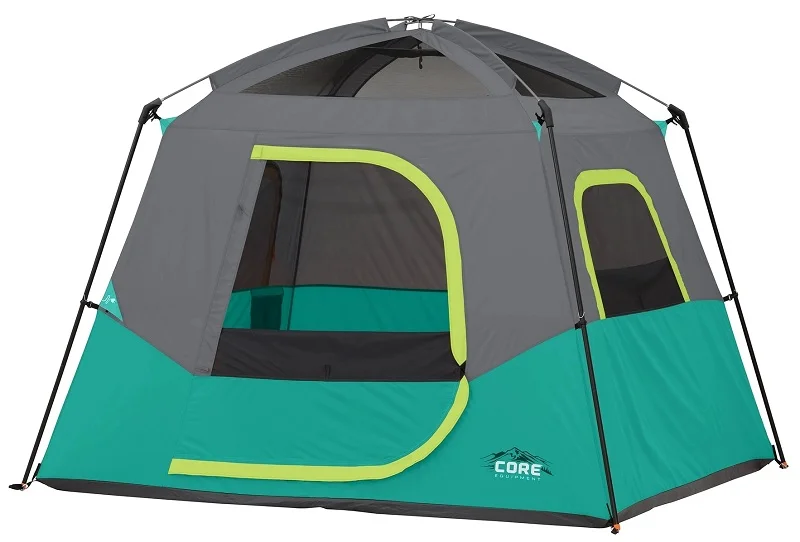
Core Equipment makes some of the most stylish camping tents that come in different styles including cabin, dome, and tunnel-like shapes. Their Core 4-Person Straight Wall Cabin Tent not only looks stunning in two hues but also packs plenty of useful features.
The tent has windows on three sides and a large D-shaped door on one side for easy accessibility and ventilation.
There’s also a partial rainfly on top of the inner tent body to keep out rainwater.
Setting up the Core 4 tent takes less than five minutes and starts by installing the canopy and then, progressing on to affixing the legs in place one by one. The sleeves can be a bit challenging to deal with at first, but it gets better after a few setups and takedowns.
While that may be a slightly lengthier process as compared to your typical instant tents, the resulting cabin-style shelter is roomy and has adequate head clearance.
The tent comes with the usual components and extras including an e-port, a gear loft for your small items, and a carry bag for hauling the tent, fly, poles, and nine 7-inch stakes. Lastly, it is moderately priced and performs just fine on other fronts as you’ll see below.
With a peak height of 72 inches, the Core 4 is one of the tallest camping tents in our selection.
At such a height, most people will be able to even stand inside the tent without bending or stooping. Further, its cabin-style and near-vertical walls also mean freer movement inside the tent as well as more usable space.
However, ample headroom and shoulder room are mostly all you will be getting with the Core 4 tent. The tent weighs more than most four-person units while providing a lesser floor area. It has a floor area of 56 square feet that spans 8 feet long and 7 feet wide.
The Core 4 weighs a hefty 13.4 pounds and packs longer than other tents as its packed size measures 27 inches long by 13 inches wide with a depth of 8 inches.
Core 4 tent features high-quality materials guaranteed to provide considerable longevity over other alternatives.
The tent’s thin canopy poles and thicker leg poles are all made of steel, a material highly praised for its strength and durability. However, steel does add some substantial heft to the whole bundle.
That said, the poles connect easily to the tent via sleeves for the roof/leg poles and by a pin and ring system at the base of the tent. Moreover, all the poles are color-coded for easier alignment and installation.
On the other end, the Core 4 tent’s inner canopy and flysheet are both made of 68-denier polyester fabric while its floor is made of 115gsm polyethylene cloth. The fabrics do a good job of protecting you from the elements and are quite durable.
The fabrics have also been infused with the manufacturer’s proprietary H20 Block technology, which mostly consists of waterproofing and dirt-repellent features.
Despite the durable materials, the Core 4 is limited to warm weather camping. It’s a 2-season camping tent at best with a hydrostatic head rating of 600MM. Plus, its partial rainfly only covers the all-mesh canopy so going beyond the two-season classification would be a disastrous undertaking.
Nonetheless, airflow is greatly enhanced by its well-rounded ventilation system that includes a large door, all-mesh ceiling, multiple windows, and floor vents. Moreover, all the openings have been meshed and zippered for custom weather control, privacy, and bug-free nights.
You similarly get some degree of moisture protection thanks to its polyurethane-coated fabrics, inverted stitching, and taped seams.
In 2019, Core Equipment released the Core 4-Person Straight Wall Cabin Tent. So far, the tent has proved to be an excellent match for anyone looking for a tall camping tent that’s easy to set up and disassemble. It features a robust ventilation system and is fairly moisture resistant.
However, it seems that the tent being tall and affordable are pretty much the only major reasons you should get the Core 4. Else, you’d just be stuck with a slightly heavy outdoor shelter with average performance.
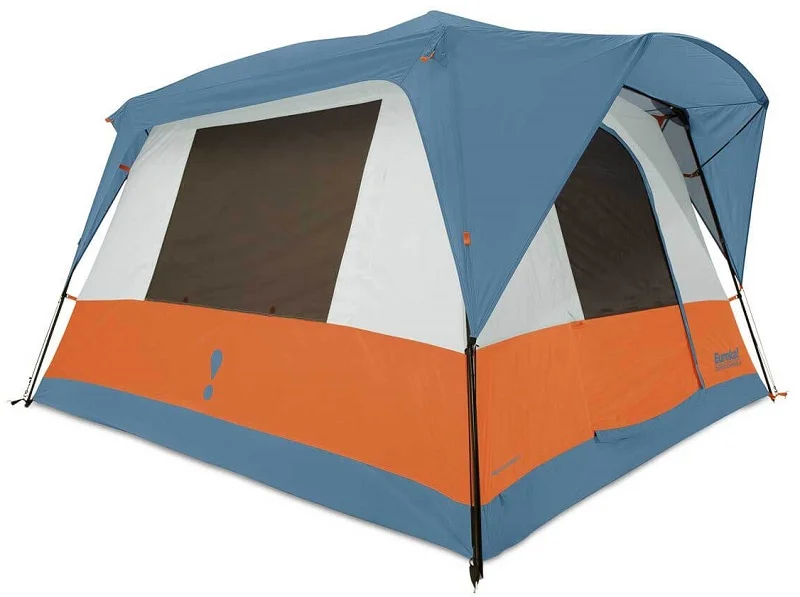
Like Coleman, the Eureka! Tent Company has been around for over 120 years making all types of outdoor gear. Some of the most notable four-person tents from Eureka! include the Space Camp 4, the Jade Canyon X4, the Tetragon NX 4, and of course, the Copper Canyon LX 4 camping tent.
Available in a Dawn Blue, Jaffa Orange, or Blue Heaven mixed color scheme, the Copper Canyon LX 4 is a tall cabin-style camping tent made for warm-weather camping.
Out of the box, it features components and accessories such as a rainfly with an integrated guylines compartment, four steel pole legs, two fiberglass roof poles, four guy ropes, eight stakes, and set up instructions.
Storage options for the tent and its components include a tent carrying bag, a stake bag, and a pole bag. When assembled, you can use the two included gear lofts to store your smaller items and the zippered E-port to pass through electrical cords.
The Copper Canyon LX 4 is easily the tallest four-person tent on the market, with a peak center height of roughly 84 inches (7 feet). The height is more than adequate for standing up straight and moving around the tent with ease. Finally, a tent for the claustrophobic folks who would like to enjoy camping!
There will be no more duck-walking or crawling to get into the tent as is the case with other tents. Heck, you might even get away with having low-profile camping cots inside the tent with minimal discomfort.
Measuring 8 feet long and 8 feet wide when fully assembled, Copper Canyon LX is a truly expansive 4-person tent. 64 square feet is plenty of space for up to three adults with minimal gear, or a 4-person family with kids.
However, its accommodative cabin-style form factor comes with minor inconveniences in terms of assemblies and teardowns.
Like most cabin-style camping tents, the Copper Canyon LX 4 tent employs multiple methods for seamless pole attachment and easier assembly. They include corner hubs for connecting all the poles, sleeves for the roof poles, clips for attaching the pole legs, and a ring and pin system to secure the legs at the bottom of the tent.
Even with all that on tow, first-timers might have a hard time setting up and taking down the tent. While the complicated pole attachment systems won’t make the exercise easier, the included instructions should come in handy.
To set up the Copper Canyon LX, you’ll need to first install the fiberglass poles into a dome-like form factor and then hoist it upwards using the steel poles. Then you can follow the usual steps of staking down and installing the fly.
The tent features thick and heavy steel poles for the legs and thinner fiberglass ones for the roof. The steel poles are quite heavy and are meant to be installed after you’ve set up the roofing. Meanwhile, the inner canopy, rainfly, and tent floor are all made of rugged 75-denier 190T polyester taffeta fabrics.
Perhaps that explains the Copper Canyon LX tent’s hefty weight of slightly over 17 pounds. It is easily one of the heaviest units we have on our list. So, if weight is a concern for you then you may want to look elsewhere for lighter camping tents.
Despite having a 1200MM hydrostatic head rating, the Copper Canyon LX is best suited for warm-weather camping. The partial rainfly, all-mesh ceiling, and overall poor rainfall protection are mostly to blame for this.
The ceiling is made entirely of mesh allowing for good air circulation. Furthermore, bug screens are installed on the huge doors and windows for maximum airflow. With that said, the included rainfly is quite small and only covers the meshed ceiling vent.
Eureka! Copper Canyon LX 4-person tent is costlier and heftier than most options out there and is only restricted to warm weather camping.
That said, it offers the most comfortable and roomy living space with plenty of headroom and great airflow. Its materials are extremely rugged and can withstand lots of abuse but only in summer camping situations or other low-stake conditions.
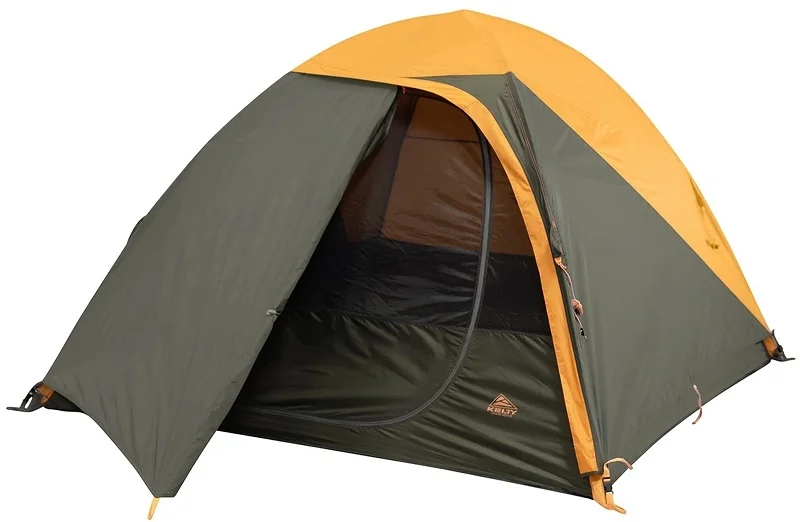
Kelty tents are preferred for their reasonable prices, non-compromise designs, and variety. Unique features such as the Quick Corner sleeves make Kelty camping tents a cut above the rest.
Some of their more notable models include the Grand Mesa, the Rumpus, the Discovery Basecamp, and the Tallboy. While all are worthy contenders, the Grand Mesa 4 is a classic among outdoor lovers.
A refreshed design of its classic dome form factor, the Kelty Grand Mesa 4 is the ultimate backpacker’s dream tent. It is spec’d out with all that you can imagine for a lightweight yet high-performance outdoor shelter.
The tent is a bigger version of the similarly designed two-person Grand Mesa 2. The biggest upgrades on the 4-person size include the Kelty Quick Corner sleeves for securing the poles at the bottom of the tent, the EZ-Zip vestibule for storing camping gear and extra weather protection, and finally the Shark Mouth stuff sack for easier tent storage and packing.
In line with its no-frills functional design, the Grand Mesa 4 features a three-quarter-way mesh inner tent and an exterior pole frame. The exterior pole frame has clip-on attachment points for quicker and easier setups and takedowns.
Meanwhile, its three-quarter-way mesh canopy is meant for weather adaptability and optimal air circulation.
The Grand Mesa 4 tent arguably provides the best weight to performance ratio we’ve seen in a tent yet. At only 7.44 pounds, the tent is the most lightweight unit we’ve seen in the four-person size category.
The choice of materials and the no-gimmicks approach taken towards the tent’s design paid off quite well with a tent perfect for backpackers. It won’t eat up too much space in the trunk or pack, and it won’t weigh you down when backpacking.
Its packed-down bundle measures 18 inches long and 7.5 inches in diameter, which makes the Grand Mesa 4 highly portable.
Although the tent is extremely lightweight, it still features durable materials and components with excellent craftsmanship to boot. It has a dome-like shape thanks to its pole frame, which is made up of two DAC Pressfit Aluminum poles that intersect over the exterior of the inner tent.
As we’ve established in our guide below, DAC (Dongah Aluminum Corporation) poles are some of the best tent poles you can get on the market today. They are acclaimed for being lightweight yet extremely durable and strong.
Moreover, the Pressfit design in the poles means that there are thicker-ended connectors inside the pole segments to make for a more durable main tubing.
And the fabrics used in the tent are equally just as high-quality.
The inner canopy has two main sections that include a mesh wall going three-quarter-way down from the roof and a polyester fabric at the base of the tent. The mesh is made of 40-denier No-See-Um netting while the tent base is made of 68-denier polyester fabric.
Further, the mesh wall has been tightly woven to keep out biting and stinging insects while still allowing in some natural light and fresh air. The included rainfly and flooring are also made of the same 68-denier polyester fabric.
That said, in a bid to keep the weight down, the tent is slightly held back by its minimal interior space and shorter ceiling height. Therefore, four people sleeping in the tent would be a stretch, and taller persons might have a hard time moving around inside the tent, and I won’t even start talking about those with claustrophobia.
Right off the bat, the Grand Mesa 4 has a hydrostatic head rating of 1800MM, which squarely categorizes it as a solid 3-season camping tent. Its polyurethane-coated inner tent, fly, and flooring ensure excellent water protection while its superb ventilation system ensures proper airflow.
Ventilation is greatly enhanced by its double-wall construction and large mesh canopy. However, it is worth noting that excessive venting might be a downside when cold weather kicks in.
In addition, privacy is a bit compromised when the rainfly is removed, and ventilation might take a hit when the flysheet is reinstalled. You will notice this especially during warmer nights or days.
If you’re looking for a lightweight four-person camping tent with minimal compromises, then the Kelty Grand Mesa 4 is worthy of your consideration. It excels at being lightweight and well ventilated.
However, it may not be roomy enough to comfortably house four persons, and accessibility may take a hit since the tent has only one door.
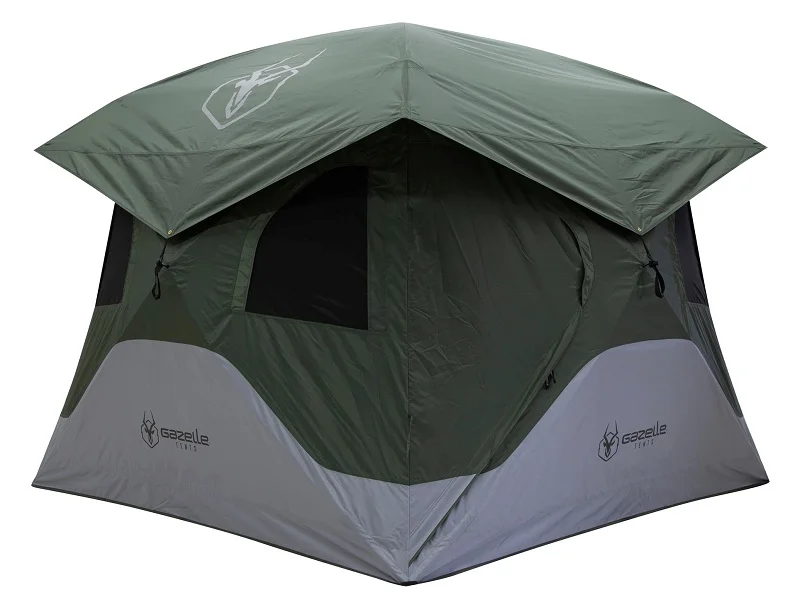
Ardisam, Inc. designs and manufactures some of the most popular outdoor gear in the market. Chief among them is the Gazelle tents brand, which has perfected the hub-style tent design. Some of the most notable tents under the brand include the T4 Hub Tent and its Overland Edition variant.
The original T4 Hub tent comes in Sunset Orange and Alpine Green colors while the Overland Edition is available in brown/orange duotones.
Out of the box, the T4 Hub tents come with a rainfly, a gear loft, 12 tent stakes, 4 guy ropes, and a carry bag. The Overland Edition (GT401SS) comes with a 300-denier footprint, all-terrain ground stakes, and a carry bag with a zipper cover and taped seams.
The hub tents measure almost 8 feet long and 8 feet wide with a tall center height of about 6.5 feet. That’s plenty of room for a full four-person occupancy including their comfortable sleeping systems. The side walls go as high as 70 inches, which means plenty of elbow and head clearances.
Moreover, the design of the tent allows for the side walls to bow out at the mid-sections for even roomier interiors.
For easier accessibility, the T4 hub tents come with two screened doors on opposite corners. However, if you have mobility limitations, its upside-down teardrop shape might be inconvenient and potentially dangerous.
Getting in your sleeping gear inside the tent can also be a hassle with these oddly shaped doors.
That said, storage and organization are a breeze thanks to the included removable gear loft and gear pockets. All the models come with two side storage pockets and up to four wall-mounted pouch pockets.
Your phone, keys, flashlight, or other small-sized valuables will be ever at arm’s reach with that many storage options.
T4's standout feature is its distinctive hub-style cabin design. The “hub” in question refers to the metal junctions used to hold the poles at the middle of the ceiling and each wall of the tent. The hubs and pole attachment design are the secret sauce to the tent’s quick and easy assembly as well as roominess.
With the whole tent pre-assembled, all you must do is grab the metal hubs and pull them outwards to open the tent. You should have it fully set up in a minute before proceeding to peg and guy it out.
The above-mentioned Gazelle Tent models come with removable floors, which can be attached using the integrated Velcro strips. This not only sets them apart but also serves a functional purpose i.e., allows for quick cleanups.
Cleaning up food crumbs, dirt, sand, or dust from your four-person tent is as easy as removing the floor and shaking the debris off.
With a weight of over 30 pounds, the Sunset Orange and Alpine Green T4 Hub tents are best reserved for car camping. The aptly named T4 Hub Tent Overland Edition is even heavier at 34 pounds.
Furthermore, all the tents collapse into a ridiculously huge bundle measuring 67.5 inches long, 8 inches in height, and 8 inches in width. Stowing and transporting either tent will require considerable space, which is a luxury in most types of camping.
Nevertheless, the tents are extremely durable and have excellent weather protection.
Their poles are made of fiberglass and connected at the junctions with all-metal hubs. Additionally, the tent is made of 210-denier Oxford-weave polyester fabric while the floors spot a 300-denier Oxford-weave polyester fabric.
Save for the easily bendable and low-quality included stakes, either of the models should give you many years of service.
The tent’s high waterproof rating, taped seams, and bathtub-style floor ensure moisture stays out. However, the partial-coverage rainfly can turn useless when experiencing heavy downpours and windy conditions. Additionally, some water might seep through the Velcro attachment points and get into the tent floor.
Ventilation is key to preventing condensation build-up inside a tent. The Gazelle T4 Hub Tents don’t leave anything to chance with their six tightly woven mesh windows and screened doors.
All three variants of the Gazelle T4 Hub tents are solid options to consider when looking for a high-performance three-season outdoor shelter. You will greatly enjoy the tall, roomy interiors and quick set-ups.
However, you better have enough trunk space and storage space at home for these bulky four-person tents as they pack down large!
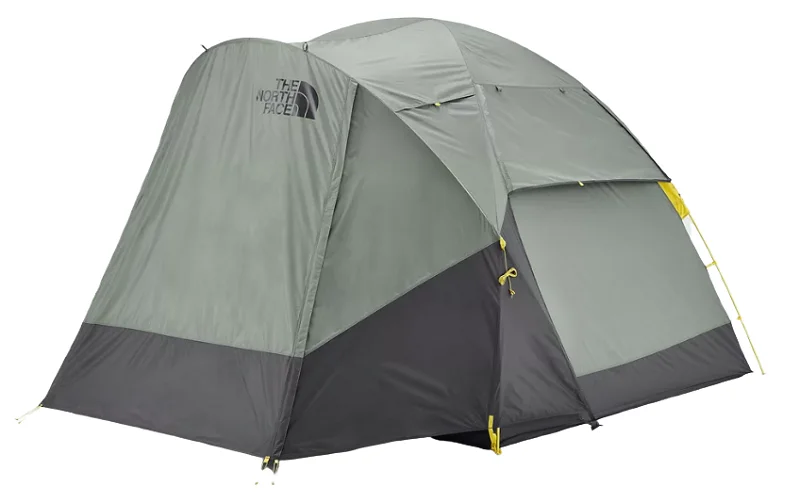
The North Face is one of the leading brands in the camping tent category. Some of the best tent brands made by The North Face company include the Stormbreaker, Bastion, Assault 2, Dome 5, and Wawona tents.
The Wawona tents come in four- and six-person sizes. The four-person variant is available in two stunning color styles: light orange/tan/taupe green and Agave green/Asphalt gray hues. Although premium-priced, the Wawona 4P packs plenty of useful and convenient features.
Right off the bat, the duffle-style stuff sack makes transporting and storing it a breeze. Additionally, the tent is the first ever to come with an included internal clothesline. The line runs along the underside of the canopy and can be very useful for hanging your clothes.
Aside from these add-ons, The North Face performs equally well in other areas such as durability, livability, and weather protection.
The Wawona 4P tent weighs only 13 pounds and packs down into a compact bundle measuring 27 inches long and 10 inches wide. It won’t take up too much of your trunk space and it won’t weigh you down too much when moving it from the car to the campsite.
Its feathery weight and portability are partly due to its compact stuff sack and materials. The tent is made of okay-quality nylon fabric and DAC MX aluminum poles. The poles are inherently light, yet they're also sturdy and responsive to the wind.
However, we suggest adding a footprint to the tent for better longevity and weather protection.
Measuring 8 feet long and 7.5 feet wide with a peak center height of about 6.25 feet, the interior of the Wawona 4P tent should suffice for a max capacity of four persons. However, the dome shape slightly eats into the interior space by slanting towards the sides.
The high ceiling of the tent ensures that all family members can stand upright comfortably without slouching. You might even be able to sit in your chairs inside the tent or front vestibule. Speaking of which, the tent has two vestibules with floor areas of 27 square feet and 14 square feet.
Either vestibule will be ideal for storing your camping gear and can even serve as a casual lounging area. While the main door is big and well-meshed, a second door on the opposite side would have been preferable.
Storing and organizing your space in the Wawona 4P tent is made easier by the included gear storage pockets and two vestibules. The pockets will be perfect for storing your phone, headlamp, books, or other valuables while the hang loops can be used to secure your lights.
Weather protection is considerably well taken care of by the sealed seams, double-wall construction, and waterproof-coated fabric. And ventilation is highly enhanced by the large, screened openings, which can be rolled up for optimal airflow.
Additionally, the ceiling vents come with kickstands, so you can rest assured that condensation build-up won’t be an issue with this tent. The Wawona 4P tent should more than suffice for 3-season camping.
The set-up process of the Wawona 4P camping tent has got to be its weakest link. Although the three poles are color-coded, having to extend and attach them to the tent can be a pain.
The main tent must be set up, the poles must be extended, and the poles must be threaded through the tent's sleeves. Thereafter, the poles are clipped together, and the tent is staked and guyed out. The entire procedure could take anywhere from five to ten minutes to complete.
In general, you should expect to pay a few more dollars for The North Face products as compared to other brands. So, the high price tag on the Wawona 4P tent is somewhat understandable. The tent should feel like a glamping option when used as a two-person unit, but it can still fit four people in a fix.
Just be prepared to encounter a lengthier setting-up process that is expected at this price range.
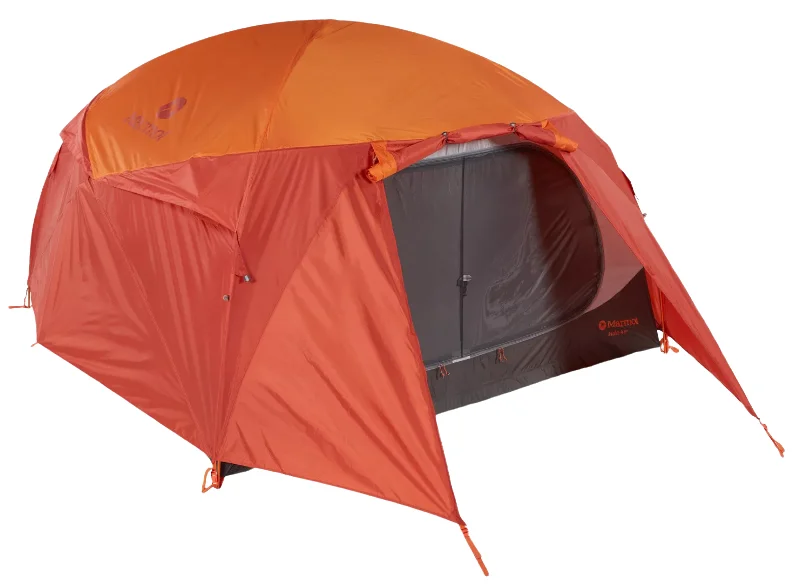
The Tungsten, Limestone, Catalyst, Limelight, and Halo are just a few of the series of camping tents made by Marmot Mountain. With its distinctive halo-like pole structure, the Halo 4-Person tent is hard not to notice.
It comes in bright orange colors that are coincidentally easier to spot during emergencies and naturally reflect heat. And that’s not all this outdoor shelter has to offer. The Halo 4-Person tent is well ventilated, weatherproof, and built for tough terrains.
The Halo 4-Person tent comes with four aluminum poles. You get two to support the main tent and the other two to bow around the top perimeter of the tent. As a result, you end up with a roomy interior with near-vertical walls and generous headroom.
It measures about 8 feet long and 8 feet wide with a peak height of almost 5 feet. Admittedly, the tent is not tall enough for occupants to fully stand up and move around. But the bowed poles do a great job at expanding the interior.
The Halo 4-Person tent should suffice for smaller families, for instance, two adults and two small kids.
Accessing the vast interior is made easy by the large double door entrance and opposite D-shaped door. Like most of the openings, the large door has a roll-up style that can be configured into an awning given the relevant accessories. Alternatively, you can just roll the flap up and tie it back to get it out of the way.
For small items, the accompanying pockets provide an off-the-floor storage solution. The 15 square foot vestibules, on the other hand, can be used to store extra goods such as your hiking boots and backpack.
However, setting up and tearing down the tent takes a little longer to accomplish as compared to other tents. This is despite having sleeves and clips for easier pole attachment and even color-coding. Other included extras are such as reflective guylines and jingle-free nylon zipper pulls.
Its DAC DA17 aluminum poles are designed to flex a bit without breaking to allow optimal support, especially when camping in windy conditions. The tent boasts of high-denier fabrics that have further been coated with waterproofing treatment for the best protection against the elements.
We are talking about a hydrostatic rating of 1800 millimeters and 2000 millimeters for the rainfly and floor, respectively. Additionally, water won’t get a chance to get inside the tent thanks to the full-coverage rainfly and taped seams.
But what about condensation issues? you ask.
The Halo 4-Person tent is very well ventilated. The rainfly has ceiling vents with little kickstands for controlled air circulation and there are a few ground-level vents too. In addition, you can remove the rainfly and window panels for unmatched airflow and stargazing opportunities.
If you are in the market for a well-built, three-season family tent, then you might want to give the Halo 4-Person tent a try. It might not be on the budget side of things, but its halo-style structure is well worth it. However, you will have to attach up to four poles instead of the usual two as found in other tents.
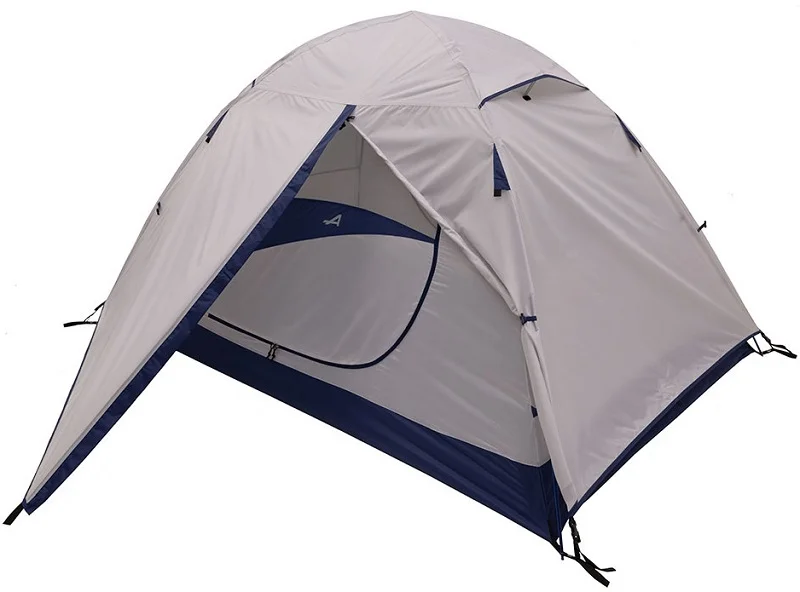
The ALPS in ALPS Mountaineering stands for “Active Lifestyle Products & Services”. Despite the suggested demographic in their name, ALPS Mountaineering tents are not reserved for experienced mountaineers.
Their four-person Taurus and Lynx tents, for instance, are very popular among all types of outdoor enthusiasts. The differences between the two tents are minimal with the price and portability being the most obvious ones.
These tents feature a two-pole dome design with large windows, two vestibules, and dual doors. With floor dimensions for both tents measuring 8.5 feet long and 7.5 feet wide, these are easily some of the most spacious four-person tents today.
The only complaint we might have here is that they are both relatively low-profile shelters. With a maximum height of just over four feet, full standing is out of the question. Then again, a low-profile dome-shaped tent often translates to better protection against strong winds.
The Lynx and Taurus four-person tents are solid three-season tents. The rainfly on either tent has a waterproof rating of 1500 millimeters and the floor is rated at a remarkable 2000 millimeters. Additionally, water is kept out by the factory-sealed seams and floor corners.
Beyond water protection, the fabrics on these tents have been treated for UV resistance. Ventilation is also well addressed by the included large, meshed openings, double-layer construction, and ceiling vents.
The poles of the Taurus tent are made of fiberglass, which is known to perform poorly in terms of durability and weight savings. This is perhaps one of the reasons for its higher weight of 10.5 pounds. Comparably, the Lynx four-person tent comes with 7000-series aluminum poles and weighs almost three pounds less.
The Lynx 4-Person tent similarly has a smaller packed size compared to the Taurus 4-Person tent. But we’re talking just a few inches here.
In both tents, the two poles intersect to form a rectangular dome-style shelter. The included pole clips make it a breeze to attach the main tent to the poles. You can easily set up or take down either tent in a matter of minutes.
However, you will want to stake down the vestibule sections tautly for a firmly grounded shelter. With that aside, the various components in either tent seem very durable and well designed.
The Taurus and Lynx four-person tents feature heavy-duty floors made of 75-denier 185-thread-count polyester taffeta fabric. The sidewalls are made of robust mesh and polyester fabric. The high denier rating and thread count of the fabrics are sure signs that the tent will serve you for longer.
Furthermore, the large, meshed windows and doors on either tent are well secured by extra-large burly #8 zippers.
The Taurus and Lynx 4-Person tents, made by a nearly 30-year-old outdoor manufacturer, include a wide, well-ventilated interior and extremely robust components. They may be a little too heavy for hikers, and the low-profile shape isn't ideal.
However, you can’t go wrong with them if you are looking for a good three-season tent. As we see it, you are getting two slightly differentiated tents with varying prices but almost the same performance.
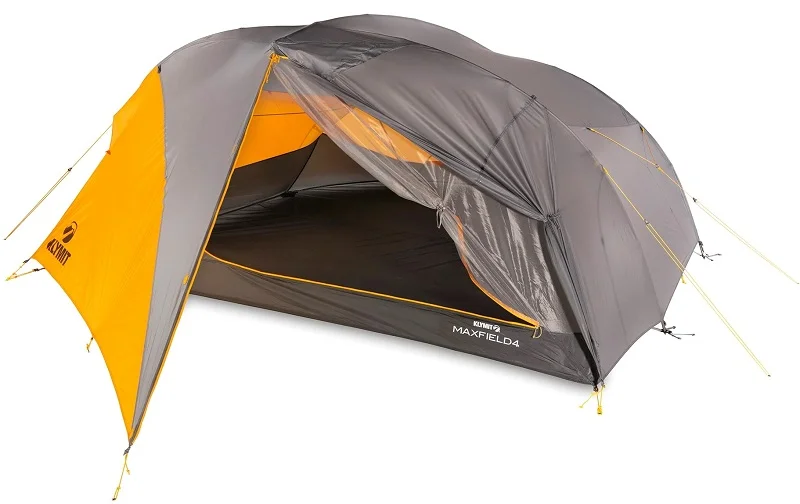
Klymit has been churning out high-quality and well-thought-out outdoor gear ever since it was founded in 2007. They first started with insulated jackets and outdoor sleeping accessories. In 2019, they entered the tent scene with the Maxfield Tent series.
The Maxfield 4 comes in noticeable orange/gray colors while the Cross Canyon 4 is available in red/gray hues. Both models can be bought in two- and 4-person sizes. Only the Cross Canyon series includes a 3-person variant.
The overall designs of the tents are geared towards making them roomy inside. The Maxfield 4 has a tapered design while the Cross Canyon 4 features a mostly rectangular profile. Both tents have almost similar-sized interiors, but the Cross Canyon tent has a higher center height.
The peak height in the Maxfield 4 is just a measly 3.75 feet while in the Cross Canyon, it’s just over five feet. Keep in mind that a higher ceiling is always preferred for the extra headroom and comfort, especially for claustrophobic persons. That aside, both tents have front and rear vestibules to help you store and organize your camping gear.
Each tent has two zippered and meshed doors, one opposite the other, for easier access to the interior.
Small items such as phones, flashlights, and books can be stashed away in the included storage pockets. While the Maxfield 4 has four storage pockets, the Cross Canyon 4 comes with three overhead pockets and two corner pockets.
A family shelter isn’t complete without proper weather protection features. The two tents have all-mesh inner canopies and come with overhead ventilation systems. These properties help deal with condensation problems and keep the interiors nice and cozy.
Without the rainfly on, the inner mesh canopy affords you bug-free stargazing opportunities and good air circulation.
Both tents have silicone or polyurethane coatings to ensure moisture stays out of the tent. Furthermore, the floors have a bathtub-like style to avoid any water splash or seepages getting into the tent.
The Maxfield 4 and Cross Canyon 4 employ pole clips and color-coding for fast and easy assemblies and teardowns. You might even halve the setup time by pitching only the fly without the inner canopy. However, be sure to bring a compatible footprint for a rainfly-only fastpitch.
That said, your first time pitching up either tent might take a little longer than expected. We found attaching the rainfly a bit challenging, especially since you have to deal with tucked-away sleeves and Velcro tabs when attaching the fly to the poles, and that’s before guying it out in the ground.
Moving on, both tents are some of the most lightweight and highly portable options around. At 5 pounds and 10.7 pounds, the Maxfield 4 and Cross Canyon 4 might even be passable for short backpacking trips.
The weight can go even lower if you go for their trail or fast-pitch configurations.
Both tents come with aluminum poles and feature light fabrics to keep the weight as low as possible. However, lightweight fabrics sacrifice longevity. The fabrics feel too light and flimsy, so you may want to get a footprint and handle them with care.
Lastly, their roll-style stuff sack is nothing we have seen in other tents. Ideally, it is just a large mat where you can place the tent components and roll them like a burrito to store them. Additionally, the sacks have clips and straps to secure everything in place.
What’s more, you can use the stuff sack as a doormat or a clean work surface to lay out the tent parts during assembly.
The Maxfield and the Cross Canyon Tent Series by Klymit are revered for their feathery weights and most importantly, their roll-style carry bag. Though heavier and a little bulkier, the Cross Canyon is a more affordable alternative to the classic Maxfield 4 tent.
Both tents will suffice as three-season shelters, but for a better experience, you should practice setting up any unit at home.
| Tent | Pole Material | Canopy & Rainfly Material | Floor Material | Weight | Set Up Dimensions (L × W × H) |
Packed Dimensions (L × W × H) |
Water Rating |
| Coleman Oak Canyon 4 Tent | Steel and Fiberglass | Polyester | Polyethylene | 40.79 lbs. | 15.42 × 9.19 × 6.23 ft. | 28.00 × 12.00 × 12.00 in. | 4500MM |
| Coleman FastPitch Instant Cabin 4 | Steel and Fiberglass | Polyester Taffeta | Polyethylene | 18.00 lbs. | 8.00 × 7.00 × 4.92 ft. | 37.50 × 9.70 × 8.20 in. | 600MM |
| Core 4 Person Straight Wall Cabin Tent | Fiberglass | 68D Polyester | 115gsm Polyethylene | 13.40 lbs. | 8.00 × 7.00 × 6.00 ft. | 27.00 × 13.00 × 8.00 in. | 600MM |
| Eureka! Copper Canyon LX 4 Person Tent | Steel & Fiberglass | 75D 190T Polyester Taffeta | 75D 190T Polyester Taffeta | 17.19 lbs. | 8.00 × 8.00 × 7.00 ft. | 27.00 × 9.00 × 9.00 in. | 1200MM |
| Kelty Grand Mesa 4 Tent | DAC Pressfit Aluminum | 68D Polyester & No-see-um Mesh, 68D Polyester | 68D Polyester | 7.44 lbs. | 8.17 × 6.67 × 4.67 ft. | 18.00 x 7.50 x 7.50 in. | 1800MM |
| Gazelle T4 Hub Tent, 22272 Gazelle T4 Hub Tent, GTR Gazelle T4 Hub Tent Overland Edition |
Fiberglass w/ Metal Hubs | 210D Oxford-weave Polyester | 300D Oxford-weave Polyester | 30.00 lbs.*34.00 lbs. (GT4) | 7.83 × 7.83 × 6.50 ft. | 67.50 × 8.00 × 8.00 in. | 2000MM - 5000MM |
| The North Face Wawona 4P Camping Tent | DAC MX Aluminum | Nylon | Nylon | 13.00 lbs. | 8.00 × 7.50 × 6.25 ft. | 27.00 × 10.00 × 10.00 in. | ~1200MM |
| Halo 4-Person Tent | DAC DA17 Aluminum | 68D Polyester Ripstop + 40D Polyester Mesh, 68D Polyester Ripstoy | 70D Polyester Taffeta | 13.74 lbs. | 8.00 × 8.00 × 4.92 ft. | 25.60 × 9.40 × 9.40 in. | 1800MM |
| ALPS Mountaineering Taurus 4-Person Tent | Fiberglass | Mesh + Polyester, 75D 185T Polyester | 75D 185T Polyester Taffeta | 10.50 lbs. | 8.50 × 7.50 × 4.33 ft. | 24.00 × 6.50 × 6.50 in. | 1500MM -2000MM |
| ALPS Mountaineering Lynx 4-Person Tent | 7000 Series Aluminum | Mesh + Polyester, 75D 185T Polyester | 75D 185T Polyester Taffeta | 7.75 lbs. | 8.50 × 7.50 × 4.33 ft. | 23.00 × 6.00 × 6.00 in. | 1500MM -2000MM |
| Klymit Maxfield 4-Person Tent | Yunan Aluminum 7001 | 20D Nylon Mesh, 15D Sil-Nylon Rip | 40D Nylon Ripstop | 5.50 lbs. | 8.00 × 7.17 × 3.75 ft. | 20.00 × 6.50 × 6.50 in. | 1200MM - 3000MM |
| Klymit Cross Canyon 4-Person Tent | Aluminum | 40D Polyester Mesh, 68D Polyester Taffeta | 75D Polyester | 10.70 lbs. | 8.33 × 7.17 × 5.42 ft. | 20.00 × 9.50 × 9.50 in. | 1800MM - 3000MM |
In the sea of brands that is the camping tents industry, a good approach to help you narrow down to the right outdoor shelter is by considering specific aspects of a decent quality tent. The weights on either of the factors will differ from person to person but are all generally very crucial when choosing a camping tent.
The ability to protect you from strong winds and inclement weather is perhaps the biggest role that tents play during camping. You’ll want to go for a camping tent that can keep water out and remain sturdy against gales.
With regards to weather protection pay close attention to features such as the tent’s wall design, various components, water resistance, and ventilation system.
Ideally, you want the tent’s interior to stay as warm and dry as possible and ensure that any water trying to seep in through the canopy, sidewalls, or floor, stays out.
A good quality camping tent should feature waterproof coating on its fabrics, fully-taped seams, and welded bathtub floors to ensure water keeps out. The waterproof rating is typically the standard measure to get a rough idea of how effective the tent’s fabrics are at keeping water out.
The waterproof rating is arrived at after carrying out hydrostatic head tests, which entails applying water pressure to the waterproof tent fabric until some water passes through. The rating ranges from about 1000MM to 10,000MM, where a higher number indicates more waterproofness of the tent.
By law, a tent fabric is deemed “waterproof” in the United States only if it has a HH rating of at least 1000MM and at least 1500MM in the European Union. Polyurethane or silicone coatings are usually the most common applicants on the tent fabric to improve waterproofing.
The groundsheet and rainfly should have a higher Hydrostatic Head rating than the main tent fabric for effective water resistance.
But what about condensation build-up in the tent due to exhaled moisture and temperature changes? Well, a good ventilation system should easily take care of that.
Good airflow in and out of the tent will not only prevent condensation from forming but also ensure that you stay cozy and dry for a restful night’s sleep. Your preferred four-person camping tent should have well-situated vents and large meshed doors and windows for optimal airflow.
The vents and zippers should feature storm flaps or be designed accordingly to ensure rainwater doesn’t get in.
Another factor to consider when it comes to weather resistance is the design of the camping tent and more so if it’s a single-wall or double-wall unit.
A double-wall tent consists of a rainfly and an inner tent with mostly mesh fabric while a single-wall unit only has the inner tent.
The rainfly in double-wall tents helps shield you from the elements i.e. strong winds and heavy downpours. Double-wall tents are more flexible to use and easy to ventilate as you can pitch only the inner mesh tent. If you fancy stargazing the night away then double-wall tents are the way to go.
On the other hand, single-wall tents are not as effective as double-wall versions, especially, at preventing condensation buildup and promoting airflow. While you may go for them for their feathery weight, always ensure they have plenty of well-situated vents for the best experience.
As earlier hinted, your dream tent should have a rainfly to protect you and the tent’s interior from rain. The rainfly should be designed such that water slides off easily and it should be large enough to cover the whole tent.
The last thing you want while camping out is your trusty outdoor shelter being blown away by heavy gusts of wind. Pitching and staking down the tent properly is always highly advisable just as much as getting strong and practically-designed poles and stakes.
We found that tent poles that crisscross were sturdier against high winds than other options. Also, go for tents with slightly thick and strong stakes that won’t bend when driven into the ground. Such a poles and stakes combo will ensure that your tent is tautly pegged and can withstand heavy downpours and high winds.
An included footprint will also come in handy as extra protection against water from the ground. Vestibules could also double up as mini-porches to wait out the bad weather aside from being useful for storing wet and muddy gear.
Finally, tents are classified according to which seasons they are most suitable to use. They range from summer screens to 2-season, 3-season, and extended 4-season tents.
Summer screens or one-season camping tents tend to be very lightweight, dirt cheap, lacking in water resistance, and less durable. They are best suited as beach shades or for camping during summer. Two-season tents are also meant for summer camping and may feature better waterproofing than summer screens.
Three-season camping tents are by far the most popular variants you’ll find today. They feature good ventilation, and solid waterproofing, and are perfect for summer and shoulder season camping. Further, they tend to have lighter fabrics and fewer poles as compared to the more rugged four-season tents.
They’re highly versatile and can be used for backpacking, thru-hiking, and full-on dispersed camping.
If you’re looking for an outdoor shelter that can withstand the harsh winter conditions then a winter tent or a four-season tent is right up your alley. These tents can bear the frigid temps, heavy snow loads on the roof, rain and snowstorms, and fierce winds related to winter camping with no huge problems.
Four-season tents feature high-denier fabrics, excellent waterproofing, less mesh ventilation sides, larger footprints, and storm flaps at the bottom of the tent. Furthermore, these tents have a waterproof index of between 5,000MM and 10,000MM or more.
In summary, tents with a waterproof rating of 1000MM to 1500MM will most likely fall under the summer and two-season camping tents. Whereas three-season tents and four-season tents will have a rating of 2000MM-3000MM and 3000MM, respectively.
Aside from adequate weather resistance, other factors that will influence the overall comfort and livability of the tent include the following:
Not all four-person tents are alike, so feel free to go for the ones with a slightly larger floor space and size. The larger size and floor space mean you can pack more gear inside the tent and that you can design the floorplan freely for optimal comfort.
You’ll especially want to go for larger four-person tents if you already have a car as your main means of transportation.
With regards to the tent shape, you’ll want to go for tents with a tapered design as that allows for ample shoulder and arm room. Plus, you save some weight by having a narrower end. Alternatively, you can go for tents with near-vertical walls for a more open interior space.
Additionally, we found the dome-style camping tents to be great at water and wind resistance while the cabin-style tents were better designed for comfort.
Also referred to as the peak height, since you’ll be packing up to four people in the tent then you must consider the ceiling height. It should be high enough for easy maneuverability within the tent, dressing up, and sitting upright.
Headroom and shoulder room are essential when it comes to comfortable living inside the tent.
As earlier mentioned, a good ventilation system is key for a comfortable tent interior. Adjustable rainfly vents, ceiling vents, and meshed doors and windows greatly boost airflow in the tent as well as take care of the condensation build-up issue.
Additionally, having meshed openings ensure that no bugs will interrupt your shut-eye and that you can also enjoy the starry sky in the comfort of your sleeping system.
Two large doors on either side of the tent will offer great accessibility into and out of the tent and won’t result in disturbing the other tent occupants. Double zippers on the doors and windows will also allow for easier access as you can open from the bottom or top.
Your dream four-person camping tent should also have inbuilt storage and organization solutions for some of your camping gear.
Multiple pockets and webbing mounted on the sides of the tent should suffice for storing your smaller items such as your phone, watch, sunglasses, wallet, etc. Gear lofts will also do for similar usage while hanging loops attached to the tent’s frame will come in handy for holding your lanterns.
Notably, you’ll want to go for tents with adjustable or removable storage options so that you can attach the pockets to wherever you need them.
If you intend on using the tent just once, then it may be okay to go for cheaper options. However, for extended camping, you’ll want to focus less on the price of the tent and more on its materials, stitching, and overall quality.
Ideally, you want the tent to withstand the harsh outdoors and perform trip after trip to recoup initial high acquisition costs (if applicable).
Tents mostly rely on poles to give them their overall frame and structure, so you don’t want to skimp here.
The poles for most tents are commonly made of either fiberglass, aluminum, or steel. DAC (Dongah Aluminum Corporation) or Easton aluminum poles tend to be more durable and lightweight than any brand of fiberglass poles but at a higher cost.
Steel poles are also acceptable as they are very strong and can withstand lots of strain without bending. However, they add significant weight to your whole camping gear bundle and thus may not be ideal if you’re limited to backpacking.
The fabric used for the main tent body may be made of either polyester, nylon, or cotton canvas among other materials. Preferably, you want the fabric to be strong enough to resist abrasion, inclement weather, and strong winds but still lightweight enough for easier portability.
Polyester and nylon tend to be very lightweight as compared to cotton canvas, but usually at the expense of strength and weather protection. Nevertheless, that’s no deal-breaker as the nylon and polyester fabrics can be strongly-stitched and waterproofed.
Look out for tents with fabrics featuring an Oxford-style or a Ripstop stitching pattern. Also, waterproof coatings such as polyurethane or silicone should bump up the tent’s water resistance and longevity.
Another aspect to consider with regards to the tent’s fabrics is the denier rating, which is essentially a measure of the thickness of the fibers in a fabric. A higher denier rating equals more rugged tent fabrics.
The specifications of your dream tent may also include ambiguous units such as “190T”, which also much like the denier rating indicate the thickness of the fabric. The “T” in 190T stands for threads per inch or thread count, so you’ll want to go for a higher thread count and a higher denier rating for the best results.
Additionally, the tent floor and footprint should be made of thick, durable, tear-resistant materials such as Polyvinyl chloride (PVC), Polyethylene (PE), or Nylon. After all, they are the most susceptible to damage due to their direct exposure to twigs, stones, and rough terrains.
Out of the box, you want the tent to come with strong stakes that are easy to drive into the ground without bending or breaking. While the stakes may be made of plastic, wood, or metal, you should always go for metal ones, particularly steel ones.
That said, stakes are relatively cheap to replace, and anyway, you will still have to buy some extra ones for specific terrains and spares.
Friendly return policies and warranty covers could also be used as fallbacks to gauge the overall quality and durability of the tent. They are especially a godsend if you’re just getting into camping or trying out different brands of tents.
Pitching a tent itself has its own steep learning curve thus any features made to improve the experience are more than welcome.
There are a couple of things that directly affect how easily a tent can be set up or disassembled. They mainly include the size of the tent, its design, and other creative add-ons such as pole hubs, color coding, and so on.
Four-person tents are slightly larger than solo tents thus they will most likely require two or more people to set up. It also goes without saying that doing a practice run in the comfort of your backyard can greatly reduce the time taken for assemblies and disassembles.
Heck, you might even manage setting up the tent by yourself after multiple trials and errors.
Is the tent freestanding or non-freestanding? Do the poles set up on the exterior or interior of the main tent?
Pop-up or instant tents are by far the quickest and easiest to set up than other types of camping tents. However, it might be tricky to find a roomy four-person version. There is also the fact that teardowns for these types of tents can be very daunting to execute for most people.
Freestanding or self-supported tents can shave off some minutes during setup as no staking is required. They work best in relatively calm weather else you’ll have to fumble with the tent pegs and guy ropes later to secure it well against the wind.
One of the key reasons you should go for freestanding tents is that they can be easily repositioned or moved entirely to wherever needed.
The positioning of the pole frame is also another factor to consider when gauging how easy it will be to set up the tent. The poles can either be attached on the outside or internally just beneath the tent fabric.
You may want to go for a four-person tent with an exterior pole frame as it tends to be far much easier to pitch. Tents with exterior pole frames also tend to be more lightweight than those with internal pole frames.
Other features that might speed up takedowns and setups include pole clip-ons or pole sleeves, pole hubs, pre-attached poles, and color-coding.
In general, tent poles come segmented for easier storage so it can be very annoying having to reattach each segment during tent assembly. Luckily, most tents will come with pre-attached pole segments either using a shock cord or telescoping mechanism.
Color coding on the various components of the tent also goes a long way in improving teardowns and assemblies. The feature helps you quickly orient the poles and find the matching pole clips or sleeves.
The poles will attach to the main body of the tent via clip-ons, sleeves, or both. You’ll want to lean more towards clip-ons for their many benefits such as easy attachment, feathery weight, and active improvement of ventilation.
Pole sleeves excel at providing a sturdier pitch but often at the expense of quick and easy assembly. Threading each pole into the sleeves can quickly turn tedious and time-consuming, which is undesirable if a downpour is imminent.
Whether you’ll be backpacking, RVing, or car camping, the portability of your outdoor shelter is also something worth looking into when choosing your ideal 4P tent. It will most likely be influenced by the overall weight of the tent, packed-down dimensions, and partly the available carrying and storage options.
In a nutshell, weight is mostly a concern when it comes to lightweight camping or backpacking. Else, given you have the storage space and means of transportation then there’s no need for forgoing roomier interiors, improved durability, and extra features as often offered by heftier tents.
That said, you’ll mostly be concerned with the packaged weight and if applicable, the minimum trail weight.
The packaged weight refers to the overall weight of the tent including its main body, poles, stuff sack, stakes, footprint, rainfly, etc. Most four-person camping tents usually weigh just slightly under 20 pounds but you may also find ultralight ones just under 10 pounds.
So, you’ll most likely have to drive to most of your camping destinations.
In some models, you may find two listed weights in the specs, which include the packaged weight and minimum trail weight.
The minimum trail weight is the overall weight of the bare minimums i.e. the tent body, poles, and rainfly. The stripped-down version of the tent may suffice for shorter camping trips and is usually very backpackable.
While car campers won’t mind going for heavy and bulky tents, it’s always advisable to consider how the tent will fit in your trunk’s space or backpack. It is even more crucial if you will be hauling your camping crew’s gear in the same vehicle.
Ensure that you double-check that the packed size of your dream tent matches your backpack or car trunk space. It also goes without saying that if you opt for a heavier camping tent then it will most likely have a large packed size.
An included rugged stuff sack or carry bag helps improve portability, especially when carrying the tent over short distances like from the car to the campsite. Compression straps on the bag also help keep the bulge down by storing the tent unit compactly.
Having considered the other key factors, some extra features and add-ons can be a good way to maximize the utility of your to-be tent.
Two-way zippers on the doors and windows help improve accessibility and can further assist in countering any breakage or malfunctions of either of the zippers over time.
You should also consider getting tents with jingle-free zippers, which have fabric pull tabs instead of metal ones. They operate “silently” and won’t attract unwanted attention by jingling during windy nights.
Reflective guy-out lines also come in handy as an extra safety precaution.
Built-in tarps and included footprints can also go a long way in improving the weather resistance of your chosen outdoor shelter. Ports at the base of the tent are also welcome features for use with electricity hook-ups in supported campgrounds.
Some tents may also come with sides that can be configured into awnings, which can be ideal for daytime lounging and mealtimes. Tents with support for minimalist shelters such as canopy-only, rainfly-only, or sunshade configurations could also serve as daytime meeting spots and cooking stations.
With up to four occupants, tents with removable internal dividers can be lifesavers, especially for two parents and their two kids.
Pole hubs enable you to configure the tent into complex forms, which results in roomier, more livable interiors and near-vertical walls. They also remove the hassle that’s often the case when attaching the poles to the tent body.
Four-person camping tents are the perfect middle ground when it comes to overall comfort and size. They’re not too small that occupants will feel crammed inside and not too large that the tents will be heavy or bulky to store or carry around.
We hope that the above information helps you select the best four-person camping tent for you. However, do keep in mind that there is no size that fits all so feel free to size up or down based on your needs.
